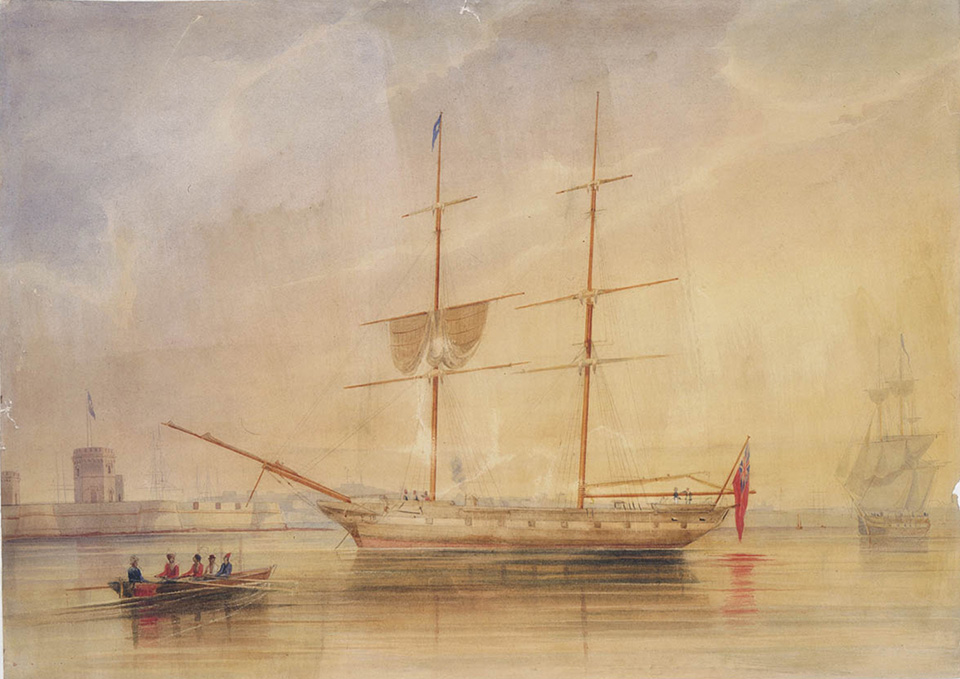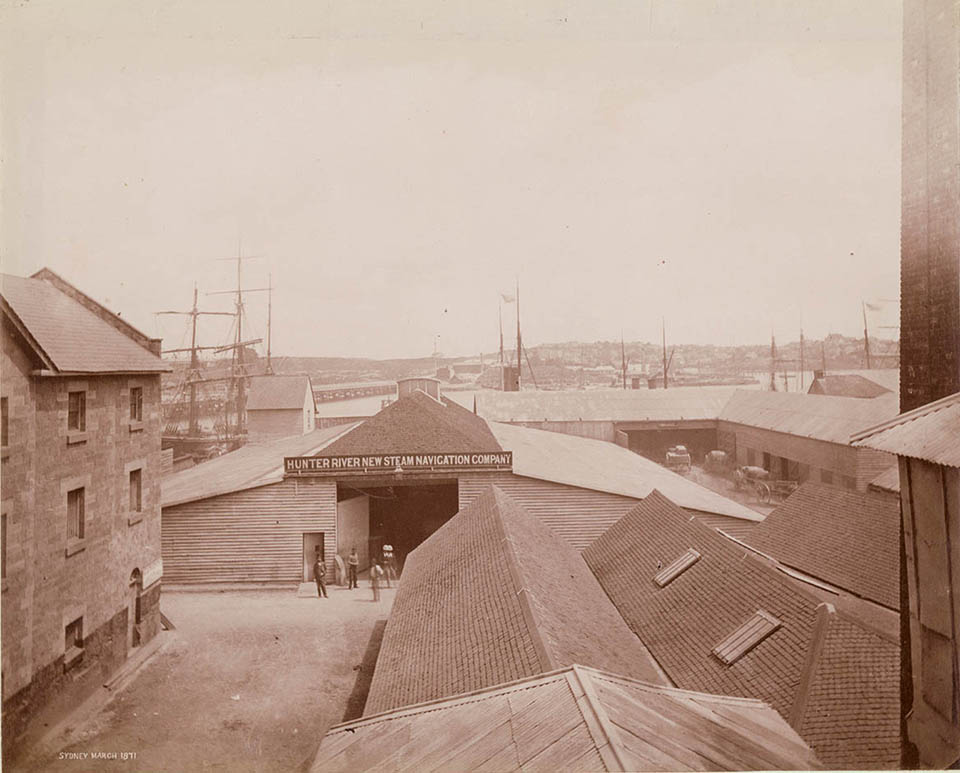The Dictionary of Sydney was archived in 2021.
Girard's wharf
Citation
Persistent URL for this entry
To cite this entry in text
To cite this entry in a Wikipedia footnote citation
To cite this entry as a Wikipedia External link
Girard's wharf
[media]When the French-born ex-convict and entrepreneur François Girard began building a steam engine and flour store in Sussex Street in 1833, [1] it was obvious even to the Sydney Gazette that he would construct a wharf adjacent to the property, to provide harbour access. As a seaport city, Sydney had 250 kilometres of harbour coastline, and demand for shipping services and wharves to service them grew exponentially as the colony grew.
As shipping was the fastest and most reliable transport method, wharves in Cockle Bay (later renamed Darling Harbour) provided landing points for shipments of grain from Parramatta and other settlements, including from Van Diemen's Land. [2] Girard's wharf in Cockle Bay was one of many privately owned wharves dotting the harbour shores in the early nineteenth century.
The wharf was in use by October 1833, as at that time the barque Dorothy Foster was advertised as discharging its cargo there, some of which must have been a significant amount of 'packing or Liverpool salt', as Girard advertised its sale by 'the Ton or Hundred Weight' at the wharf only days later. [3] [media]Activities at the wharf greatly increased in August 1834 when Girard announced his co-located flour mill and stores were 'open to the reception of Grain'. He advertised that
The Premises are very convenient for the reception of Grain both by land and water … for the convenience of those Persons who reside at a distance from Sydney, the Wheat which shall be brought to the Mill will be ground forthwith, and the Flour return with as little delay as possible. [4]
The deep water of Cockle Bay – 18 feet (5.4 metres) or more close to the shores [5] – made its wharves convenient for a broad range of vessels including sea-going ships. Girard wrote to his wife's relatives that he had a 'waterside of 100 upon 150 feet, and where a ship of 5 or 600 tons may discharge alongside'. [6] The wharf was conveniently located, as Sussex Street then reportedly conveyed more valuable goods through it than another other Sydney street. [7] The wharf serviced cargo and also provided access to ferry boats; the steam boat Experiment began using the wharf as its Sydney landing for passengers to and from Parramatta. [8]
Girard expanded his wharfage over the years to create an impressive facility by 1837. Eventually the site required a new thoroughfare and Napoleon Street was constructed, and supposedly named by Girard after the Emperor he had proudly served earlier in the century. He enthusiastically advertised his wharf as having the advantage of offering 'every facility to shipping' and 'being the most central Waterside Premises in Sydney'. [9] Vessels such as the brig Speculator began regular schedules between Girard's wharf and ports in the other colonies, such as Port Phillip in Victoria and Launceston in Tasmania. From Tasmania, Girard attracted and purchased many cargoes of grain to supply his mill.
Smaller vessels also sailed between the wharf and the New South Wales north coast ports near the Macleay, Clarence and Manning rivers. Girard boasted that as 'five Vessels can be loaded and unloaded at once, no delay will be experienced' at the wharf. He particularly specialised in servicing schooners carrying cedar from the north coast of New South Wales, where he held timber and shipbuilding interests:
This Wharf is spacious, and therefore convenient for discharging Cedar, and to prevent any trouble to those who have Goods to send and bring to the Wharf, the undersigned has always sufficient number of Horses to Cart such Goods, and for which a charge will be made at the same rate per load or tea as is generally charged at the King's Wharf. A quantity of Ballast will always be on the Wharf for Vessels at the same price as charged by the Ballast Boats. [10]
Activities at Girard's wharf became increasingly diversified. In December 1834 he opened a saw mill which featured the use of circular saws, [11] then a timber yard and later a stone quarry. [12] Auctions of goods from overseas and intercolonial trade were regularly held, and one could buy everything from potatoes, soap, sugar and oil to livestock. [media]By 1837, the proprietor appeared as the owner of a number of 'fine, fast-sailing traders' including the Francis, Eliza and Taree (sometimes called Tarree), and the brig Sarah plying regularly to Port Macquarie. [13] Girard added the schooner Francis Napoleon and the brig Alfred [14] to his fleet in 1838. [15]
[media]In 1840, as a consequence of Girard taking up land on the Clarence River and failing to lease the premises, Girard's now-famous wharf and his Napoleon Street river frontages were sold; the Australian Steam Navigation Company adapted the south end of the wharf for steamers and it became known as the Hunter River wharf. [16] Girard's Mill was taken over by the Sydney Flour Company in 1841. [17]
References
Sydney Gazette, 4 April 1837, p 3
PR Stephensen and Brian Kennedy, The history and description of Sydney Harbour, 2nd edition, Reed, Sydney, 1980
J Waldersee, 'Emancipist in a Hurry: Francois Girard', Journal of the Royal Australian Historical Society, vol 54, part 3, September 1968, pp 238–255
Notes
[1] Sydney Gazette and New South Wales Advertiser, 14 September 1833, p 2
[2] PR Stephensen and Brian Kennedy, The history and description of Sydney Harbour, 2nd edition, Reed, Sydney, 1980, p 158
[3] Sydney Gazette, 10 October 1833, p S1, 12 October 1833, p 3
[4] Sydney Gazette, 24 July 1834, p 1 advertisement
[5] PR Stephensen and Brian Kennedy, The history and description of Sydney Harbour, 2nd edition, Reed, Sydney, 1980, p 146
[6] F Girard to Patt Hayes (brother-in-law), 18 December 1833, Hayes Letters, State Library of NSW, Mitchell Library A3586
[7] PR Stephensen and Brian Kennedy, The history and description of Sydney Harbour, 2nd edition, Reed, Sydney, 1980, p 159
[8] Sydney Gazette, 2 September 1834, p 1
[9] Sydney Gazette, 28 November 1839, p 1
[10] Sydney Gazette, 4 April 1837, p 3 advertisement
[11] Sydney Gazette, 30 December 1834, p 1
[12] Sydney Gazette, 5 October 1839, p 2 advertisement
[13] J Waldersee, 'Emancipist in a Hurry: Francois Girard', Journal of the Royal Australian Historical Society, vol 54, part 3, September 1968, p 250; Sydney Gazette, 10 December 1836, p 3
[14] NC Keats, Wollumbin: the creation and early habitation of the Tweed, Brunswick and Richmond Rivers of NSW, the author, Point Clare NSW, 1990, p 125 citing Bawden's lectures, pp 35–36
[15] Sydney Gazette, 9 January 1838, p 2
[16] Sydney Herald, 25 March 1840, p 2; Sydney Gazette, 11 April 1840, p 1
[17] Australian, 2 January 1841, p 2
.





